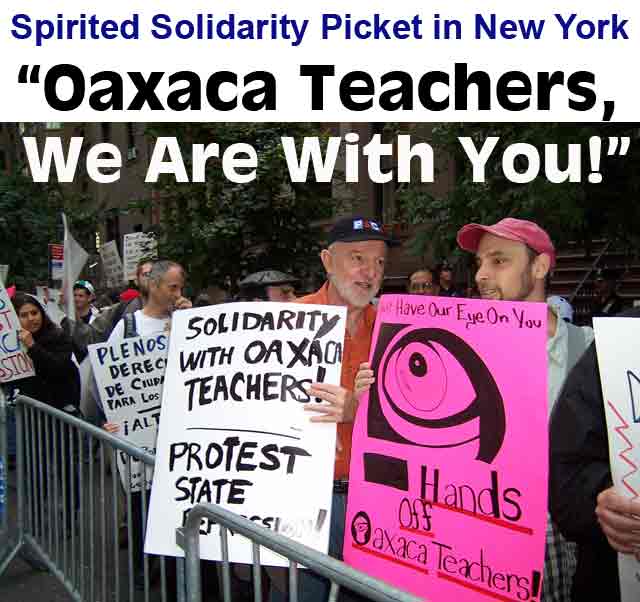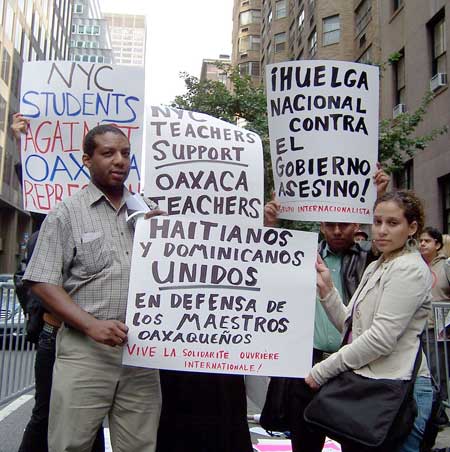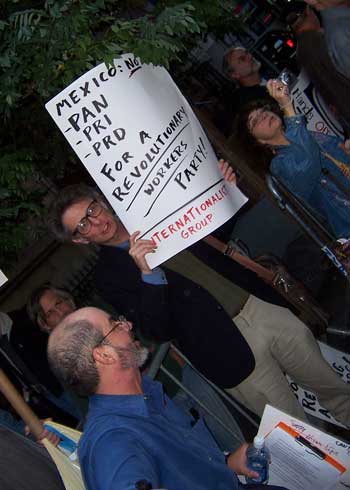
September 2006

Demonstrators outside Mexican consulate in New York City, September 21. (Internationalist photo)
“Maestros
oaxaqueños, estamos con ustedes” (Oaxaca teachers, we are
with you), the
NYC demonstrators chanted. The chant was so loud, in fact, that it was
heard
all the way to Oaxaca, via a live broadcast from the picket line to the
strikers’ station, Radio Plantón (Sit-In Radio). Pictures of the
protest were
printed in El Diario-La Prensa in New York and La Jornada
in
Mexico City. On the same day in Rio de Janeiro, Brazil, members of the
teachers
union (SEPE) from the steel city of Volta Redonda carried a banner
proclaiming:
“SEPE-V.R. Calls on the Working Class to Strike in Solidarity with the
Teachers
in Oaxaca, Mexico.”
The
New York protest exceeded the organizers’ expectations, as protesters
kept
arriving. Soon it was almost impossible to move in the narrow area
blocked off
by steel barriers set up by the police to cordon off demonstrations.
Picketers
chanted, “From New York to Oaxaca, fight for the right to strike!”
Other chants
included, “Oaxaca, Atenco, massacres in Mexico,” “International
solidarity with
Mexican teachers,” “Defend Mexican teachers against death squad terror”
and “¡Viva
la huelga de los maestros oaxaqueños!”
An
important aspect of the Oaxacan teachers’ struggle is the fight against
the
oppression of the indigenous peoples of this state, where more than a
third of
the population speaks native languages. One of the signs carried in the
September 21 protest carried a greeting in Mixteco from a Oaxacan
teacher
thanking New York teachers for their support. Another declared in
Spanish:
“Against Racism, Discrimination and State Terror, Defend the Indigenous
Peoples
of Oaxaca and Chiapas!” (A large majority of the striking teachers in
this
heavily indigenous state are women, many from the Zapotec, Mixtec,
Mixe, Triqui
and other Indian peoples.)
The
united-front protest was in response to a call endorsed by more than 70
individuals and organizations, including scores of professors from the
City
University of New York (CUNY) and teachers from the city’s public
schools. For
several weeks, union activists from the Professional Staff Congress
(PSC,
representing CUNY faculty and staff) and the United Federation of
Teachers (UFT)
have been gathering support for the protest in support of the Oaxaca
teachers.
The Internationalist Group and supporters in the PSC and UFT as well as
members
of the Internationalist Clubs at CUNY played an important role in
initiating
and building the protest.
 The
broadcast over Radio Plantón was particularly important, lasting
for 25 minutes
before the connection was broken. The strikers prepared beforehand to
transmit
on all the occupied radio stations in Oaxaca. So when the call from New
York
came in, four other stations (Radio La Ley, Radio APPO, and others)
were
networked in. Amid the chanting some of the signs carried by protesters
were
mentioned, among them the call for full citizenship rights for all
immigrants.
A student from the CUNY Internationalist Clubs spoke from personal
experience
growing up in the state of Guerrero about the racism directed against
indigenous peoples in Mexico. CUNY professor Electa Arenal sent
greetings to
the Oaxacan teachers she had met while attending a tri-national
(U.S.-Canada-Mexico)
conference in defense of public education there last March.
The
broadcast over Radio Plantón was particularly important, lasting
for 25 minutes
before the connection was broken. The strikers prepared beforehand to
transmit
on all the occupied radio stations in Oaxaca. So when the call from New
York
came in, four other stations (Radio La Ley, Radio APPO, and others)
were
networked in. Amid the chanting some of the signs carried by protesters
were
mentioned, among them the call for full citizenship rights for all
immigrants.
A student from the CUNY Internationalist Clubs spoke from personal
experience
growing up in the state of Guerrero about the racism directed against
indigenous peoples in Mexico. CUNY professor Electa Arenal sent
greetings to
the Oaxacan teachers she had met while attending a tri-national
(U.S.-Canada-Mexico)
conference in defense of public education there last March.
As
demonstrators called to fight for the right to strike, we explained to
listeners that under New York’s anti-labor Taylor Law, public sector
workers
are banned from striking here, yet last December the powerful Transport
Workers
Union (TWU) shut down the city’s subways and buses for three days.
Despite
massive fines, the TWUers were unbroken. A spokesman for the
Internationalist
Group explained to listeners that this was intimately connected to the
burning
need for a revolutionary workers party, both in the U.S. and Mexico,
because
all the bosses’ parties supported repression against the strikers. The
announcer in Oaxaca said that many strikers had expressed the need for
a party
representing the working people.
The
picket was being broadcast while Oaxacan strikers were beginning a long
trek by
foot to Mexico City that is expected to last two weeks. Marchers
listening to
the broadcast from the striker-occupied radio stations called in
questions to
Radio Plantón to pass on to the protest in New York. One
listener wanted to
know what unions were represented (dozens of members of the PSC, UFT
and TWU).
Another asked if any document had been brought to the consulate. We
reported
that a New York teacher and a high school student had tried to deliver
a letter
from UFT president Randi Weingarten protesting the repression against
Oaxacan
teachers, but they were rebuffed.
There
is no doubt that the radio broadcast gave marchers trekking through the
Oaxacan
countryside a real lift hearing the chanting from New York and knowing
that
there was a large and combative solidarity demonstration in the heart
of U.S.
imperialism supporting the strikers. Now the right-wing government of
Mexican
president Vicente Fox is threatening to send in federal forces to
dislodge the
teachers. Governor Ulises Ruiz has issued an ultimatum for teachers to
return
to work by Monday, September 25, or he will replace them with scabs and
send in
the police. It is urgent for the working class internationally to come
to the
aid of our class sisters and brothers in Oaxaca.
Bloody
Repression, Hard Class Struggle
For
the last four months the Oaxacan teachers and their supporters have
been
engaged in a hard and protracted class battle, the likes of which
hasn’t been
seen in Mexico in several decades. On June 14, the governor sent an
army of
3,500 riot police to evict strikers camped out in 52 blocks in the
heart of the
state capital. The repressive forces let off repeated volleys of tear
gas (and
rifle fire), burned the strikers’ tents, invaded the teachers union
headquarters, destroying the strike radio station, and brutally beat
anyone
they came across. But after a tenacious struggle, tens of thousands of
teachers
retook the city center.
Two
days later 300,000 people marched in solidarity with the teachers. Ever
since,
the entire city has been in the hands of the teachers and their allies.
Police,
often masked, periodically sneak into town for nighttime incursions in
unmarked
vehicles. After one such raid in late August, in which a strike
supporter was
shot to death by a marauding “caravan of death,” more than 500
barricades were
thrown up all around Oaxaca city. The city hall, state legislature,
supreme
court and governor’s office are all occupied, as well as several radio
stations
and the state government’s TV channel.
Upon
receiving phone reports from our comrades of the Grupo
Internacionalista in
Mexico about the bloody June 14 cop attack on the striking teachers,
the Internationalist
Group in New York called an emergency protest outside the Mexican
consulate on
an hour’s notice. The IG initiated a second demonstration at the
consulate the
following day which was joined by a large contingent from the PSC.
Photos of
that demonstration were published in the Mexico City daily La
Jornada and
in Noticias in Oaxaca, the widely read daily newspaper which is
supporting the teachers.
Over
the next two and a half months, militants of the Grupo
Internacionalista were
in Oaxaca almost constantly, distributing thousands of leaflets to the
strikers
and talking of the need for a national strike against the murderous
government,
the formation of workers defense committees and fighting to forge
class-struggle unions to break the stranglehold of the corporatist
“unions”
which for decades acted as labor police for the PRI (Institutional
Revolutionary Party). A particular focus was the GI’s call to break
with the
popular front around the bourgeois-populist Party of the Democratic
Revolution
(PRD) led by presidential candidate Andrés Manuel López
Obrador, widely known
by his initials AMLO.
This
was a key issue among the teachers, since after saying for a month that
they
would boycott the July 2 elections, the union leadership and their
allies in
the Popular Assembly of the People of Oaxaca (APPO) ended up calling
for a
“punishment vote” against the hated PRI (Institutional Revolutionary
Party) of
the bloodthirsty governor Ruiz, which ruled Mexico for 70 years and was
still
in power in Oaxaca, and against the right-wing clericalist PAN
(National Action
Party) of Mexican president Fox. This popular-frontist appeal amounted
to a
call to vote for AMLO and the PRD, which 46 percent of the voters in
the state
did. At the end of July, supporters of the Grupo Internacionalista held
a video
showing of the film “Land and Liberty” about the Spanish Civil War and
forum on
the popular front which drew several dozen strikers.
In
August, a youth leader of the GI addressed a mass meeting of 1,500
strike
supporters in Oaxaca called by the APPO, declaring that there would be
no
“democracy” under capitalism for the poor and working people, women and
indigenous peoples, denouncing the role of the PRD, and calling for a
revolutionary workers party. As PRD supporters attempted to shout him
down, our
comrade held his ground, while a number of teachers called out to “let
him
speak.” In the end he got more applause than a PRD senator. Striking
teachers
crowded around to see photos of the June 14 and 15 protests in New York
City
and effusively asked IG supporters to convey their thanks to NYC
teachers for
their solidarity. 198 copies of a new issue of the Mexican edition of El
Internacionalista were sold as strikers lined up and called out for
copies.
 The
struggle of the Oaxaca teachers figured prominently in a Grupo
Internacionalista forum on “Mexico: Bourgeois Elections and Workers
Blood” and
“Revolution and Counterrevolution in the Post-Soviet World” held in the
Leon
Trotsky Museum in Coyoacán (Mexico City) on August 19, the eve
of the
anniversary of Trotsky’s murder there by a Stalinist agent in 1940.
Starting in
late August, supporters of the International Group back in New York
began
agitating and working with activists of the PSC and UFT, to build a
labor
protest of solidarity with the embattled Oaxacan teachers. UFTers to
Stop the War was among the initiators of the demo. Although the union
tops refused to endorse, many individual
members enthusiastically did.
The
struggle of the Oaxaca teachers figured prominently in a Grupo
Internacionalista forum on “Mexico: Bourgeois Elections and Workers
Blood” and
“Revolution and Counterrevolution in the Post-Soviet World” held in the
Leon
Trotsky Museum in Coyoacán (Mexico City) on August 19, the eve
of the
anniversary of Trotsky’s murder there by a Stalinist agent in 1940.
Starting in
late August, supporters of the International Group back in New York
began
agitating and working with activists of the PSC and UFT, to build a
labor
protest of solidarity with the embattled Oaxacan teachers. UFTers to
Stop the War was among the initiators of the demo. Although the union
tops refused to endorse, many individual
members enthusiastically did.
The
IG had a stand at the annual West Indian Day Parade in Brooklyn on
September 4,
selling copies of The Internationalist with several articles
on the hot
struggles in Mexico. A well-attended forum was held by the Hunter
Internationalist Club on September 7 showing a just-completed video
produced by
the Internationalist Group on “Class Battles in Mexico” (copies of the
video
are available for sale). On September 9, several hundred leaflets
calling for
the protest along with a fact sheet on events in Oaxaca were
distributed and
dozens of endorsements for a protest gathered at the Labor Day parade,
despite
the wretched Democratic (and in some cases Republican) politics of the
pro-capitalist union tops.
On
September 14, a “report-back” meeting was held at the City University
Graduate
Center, sponsored by the Association of Latino and Latin American
Students and
endorsed by the PSC, CUNY Internationalist Clubs and the Doctoral
Students
Council. In a room packed to overflowing with more than 60 people, CUNY
faculty
who recently were in Oaxaca recounted the struggle there and segments
were
shown from a video shot and being edited by Professor Tami Gold of the
Hunter
Film Department. After the presentations there was a lively debate with
more
than a dozen speakers in the audience over the role of the PRD, the
nature of
the corporatist “unions” in Mexico and the need for solidarity action
in the
United States.
On
September 17, flyers were distributed and 50 copies of El
Internacionalista
sold at the Mexican Independence Day festival in New York. As momentum
built
for the picket, an IG spokesman gave an interview on WBAI radio
emphasizing key
aspects of the struggle in Oaxaca, including the important issue of
racism
against indigenous peoples. The Hunter Internationalist Club held a
sign-making
session making dozens of signs. In Mexico City, the Grupo
Internacionalista
held a forum on the teachers’ struggle, with students who traveled from
Oaxaca
speaking, at the CCH-Sur preparatory school which was attended by over
100
students. Meanwhile, in Brazil, supporters of the Liga
Quarta-Internacionalista
do Brazil, section of the League for the Fourth International, were
pushing for
the teachers union there to demonstrate support for the Mexican
strikers. In
all three countries, the Internationalist video was shown.
These
intense efforts prepared the way for the successful September 21
protest. At
the picket, an Internationalist Group leaflet was distributed with an
update
from Mexico on the “Threat of Heavy Crackdown in Mexico.” At the end of
the
hour-long protest, the crowd was addressed by a number of the
participants. An
executive board member of TWU Local 100 spoke of the battle for the
right to
strike and against the union-busting Taylor Law, after which
demonstrators
again chanted to fight for the right to strike. A prominent member of
the PSC
spoke of how teachers in Oaxaca had inspired teachers in New York, and
of the
need for the working class to become active against the war. Protesters
chanted
“For workers strikes against the war!” and “Defeat U.S. Imperialism!”
An
activist from the UFT told how the consulate refused to receive the
letter from
the NYC teachers union, with 150,000 members, against the repression in
Oaxaca.
There
were also speakers from Grassroots Haiti, the CUNY Internationalist
Clubs, the
International Socialist Organization, the League for the Revolutionary
Party,
Progressive Labor Party and the Spartacist League. The speaker from the
Internationalist Group emphasized that the key issue is revolutionary
leadership:
the Oaxacan teachers have certainly shown tenacity and courage, and
have
massive popular backing, but the strike is undercut by the leadership’s
support
for the PRD, many of whose members have been scabbing on the strike and
whose
legislators are now calling to bring in the Mexican federal police to
dislodge
the strikers. The fight against massive poverty, to defend immigrants’
rights,
to defeat the imperialist war on Afghanistan and Iraq, both in Mexico
and the
U.S., require the leadership of a revolutionary workers party.
To contact the Internationalist Group and the League for the Fourth International, send e-mail to: internationalistgroup@msn.com